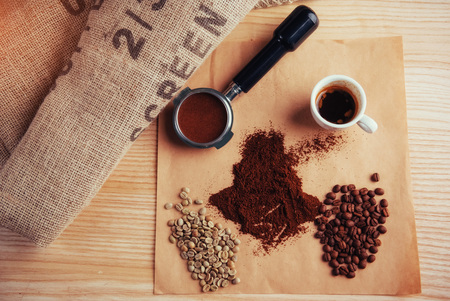Introduction to Indian-style Coffee Culture
India’s tryst with coffee is as flavourful and diverse as its culture. While the world may know India for its masala chai, the country boasts a vibrant legacy of coffee brewing that reflects centuries of tradition, innovation, and regional flair. From the aromatic filter kaapi of Tamil Nadu—brewed strong and sweet with chicory—to the robust black coffees of Coorg and the frothy, spiced variants found in North India, Indian coffee culture is shaped by local tastes and the abundant use of indigenous spices. Spices such as cardamom (elaichi), cinnamon (dalchini), cloves (laung), and black pepper (kali mirch) have long played a pivotal role in transforming a simple cup of joe into an immersive sensory experience. Exploring these unique blends at home not only celebrates India’s rich agricultural heritage but also opens up a world of creative possibilities for coffee lovers keen to experiment with traditional flavours. Whether you prefer your brew mild or bold, sweet or spicy, the Indian approach to coffee invites you to discover new layers of taste by infusing your daily cup with locally sourced spice mixes, reflecting both regional preferences and personal style.
2. Selecting Local Indian Spices for Coffee
India’s culinary tapestry is interwoven with a rich heritage of spices, each carrying its own story and aroma. When it comes to brewing coffee at home with an authentic desi twist, the selection of spices becomes crucial. The most popular Indian spices that can elevate your cup include cardamom (elaichi), cinnamon (dalchini), and cloves (laung). These spices are not just ingredients; they are cultural touchstones, used for centuries in traditional drinks like masala chai and festive desserts. Their integration into coffee transforms an everyday beverage into a celebration of Indian flavours.
Popular Indian Spices for Coffee
| Spice | Local Name | Flavour Profile | Cultural Significance |
|---|---|---|---|
| Cardamom | Elaichi | Sweet, aromatic, slightly citrusy | Widely used in South Indian filter coffee and festive sweets |
| Cinnamon | Dalchini | Warm, woody, subtly sweet | A classic in winter beverages and Ayurvedic remedies |
| Cloves | Laung | Pungent, spicy, intensely aromatic | Mainstay in garam masala blends and celebratory drinks |
The Desi Approach to Spice Selection
Choosing the right combination of these spices depends on personal taste and regional preferences. In South India, cardamom is often the star, lending an unmistakable fragrance to traditional filter kaapi. Northern households may favour the warmth of cinnamon and cloves, reminiscent of spiced winter treats. The key is to use whole or freshly ground spices for maximum aroma—pre-ground powders tend to lose their punch over time.
Tip:
If you’re experimenting for the first time, start with a pinch of one spice per cup and adjust according to your liking. Overpowering amounts can mask the natural notes of your coffee beans.

3. Preparing Your Spice Mix Masala
To truly capture the essence of Indian coffee with a unique twist, the secret lies in crafting your own masala – a spice blend that brings together tradition and innovation in every sip. Begin by selecting whole spices such as green cardamom (elaichi), cinnamon sticks (dalchini), cloves (laung), black peppercorns (kali mirch), and a hint of nutmeg (jaiphal). For an extra layer of aroma, you may also include dried ginger (saunth) or star anise (chakriphool), popular in various regional chai and coffee recipes.
Tried-and-Tested Blending Techniques
Start by gently roasting your selected spices on a low flame in a dry pan. This traditional method, used across Indian kitchens, helps to release essential oils and deepen their flavours without burning them. Once cooled, grind the roasted spices using a stone mortar-pestle or an electric mixer-grinder until they form a fine powder. Remember, freshness is key: always prepare small batches to retain optimal aroma and taste for your home-brewed coffee.
Pro Tip: Balancing Flavours
Each household often customizes its masala to suit family preferences; some prefer more warmth from black pepper, while others love the sweetness of cinnamon and cardamom. Experiment with proportions – start with 2-3 pods of cardamom, half an inch of cinnamon stick, 2-3 cloves, 4-5 peppercorns, and a pinch of grated nutmeg per batch. Adjust to taste for your signature blend.
Storing Your Coffee Masala
Keep your freshly ground masala in an airtight container away from sunlight and moisture – just as Indian grandmothers have done for generations. Use within two weeks for the most vibrant flavours in your spiced coffee creations. By preparing your own masala at home, you ensure each cup celebrates local ingredients and the layered richness of India’s culinary heritage.
4. Brewing Techniques Inspired by Indian Households
India’s coffee culture is as diverse as its landscape, with each region and household nurturing unique brewing rituals handed down through generations. Traditional Indian coffee-making is a celebration of patience, precision, and aromatic blends—particularly when local masalas (spice mixes) are infused into the process. Let’s uncover how you can replicate these time-honoured techniques at home to create truly distinctive coffee flavours.
Filter Coffee: The South Indian Way
Perhaps the most iconic home-brewing method in India is the South Indian filter coffee. Using a metal filter, freshly ground coffee is steeped overnight, yielding a rich, concentrated decoction. When mixed with hot milk and sugar—and enhanced with a pinch of cardamom or nutmeg—the result is an aromatic beverage that awakens the senses.
Stovetop Decoction: North Indian Flair
In many North Indian homes, coffee is brewed on the stovetop using a simple saucepan. Water and ground coffee simmer together, releasing robust flavours. Here, it’s common to add local spices like cinnamon or clove during the brewing stage for an extra layer of warmth and depth.
Brewing Methods Comparison
| Method | Region | Key Spices Used | Brewing Time | Taste Profile |
|---|---|---|---|---|
| Filter Coffee | South India | Cardamom, Nutmeg | 8-12 hours (steeping) | Smooth, aromatic, creamy |
| Stovetop Decoction | North/Central India | Cinnamon, Clove, Ginger | 5-10 minutes (boiling) | Bolder, spiced, intense |
| Instant Masala Coffee | Panjab/Gujarat/Urban | Pepper, Dry Ginger, Fennel Seeds | 2-3 minutes (instant mix) | Quick, spicy-sweet notes |
Enhancing Your Brew with Local Masalas
No matter which method you choose, adding a locally sourced masala can transform your cup into an authentic Indian experience. Experiment by blending your favourite spices—be it elaichi (cardamom), dalchini (cinnamon), or saunf (fennel seeds)—with coffee grounds before brewing. This not only amplifies aroma but also reflects the creative spirit found in Indian kitchens across the country.
5. Creative Coffee Recipes Featuring Indian Spices
India’s vibrant culinary heritage offers a treasure trove of spices that can transform your daily cup of coffee into an aromatic adventure. Whether you’re nostalgic for the comforting warmth of your grandmother’s kitchen or eager to experiment with contemporary café-style concoctions, integrating Indian masalas into your coffee ritual is both a celebration of tradition and an exploration of new tastes.
Masala Chai Coffee: A Fusion Favourite
Bring together two of India’s most beloved beverages with Masala Chai Coffee. Brew a strong South Indian filter coffee or robust espresso as your base. In a separate saucepan, simmer water with crushed ginger, cardamom pods, cinnamon sticks, cloves, and black peppercorns—mirroring the classic chai masala mix. Combine the spiced infusion with your coffee, add milk and sugar to taste, and enjoy a warming drink that evokes both nostalgia and novelty.
Filter Kaapi with a Spice Twist
The iconic Filter Kaapi gets an aromatic upgrade with local spice infusions. While preparing your decoction using a traditional stainless steel filter, sprinkle in a pinch of freshly ground nutmeg or star anise for subtle sweetness. For those who love bold flavours, try adding a dash of dry ginger powder (saunth) or even a hint of fennel seeds. The result? A cup that pays homage to the roots of South Indian coffee culture while embracing inventive flair.
Experiment Beyond Tradition
If you’re feeling adventurous, look to regional classics like Punjabi-style coffee with dalchini (cinnamon) or Maharashtrian-inspired brews using goda masala—a blend typically reserved for savoury dishes but surprisingly delightful in small doses with dark roast beans. Don’t hesitate to play around: add a few saffron strands to your brew for a luxurious touch or garnish your Dalgona coffee with powdered elaichi (cardamom) for an Instagram-worthy finish.
These recipes are just starting points—let your palate guide you as you experiment with locally sourced spices. Each cup is an invitation to rediscover India’s rich sensory legacy from the comfort of your own home.
6. Serving and Pairing Suggestions
Bringing your spiced coffee experience to life involves more than just brewing; its about creating an authentic Indian moment at home. Presentation matters, and in India, serving coffee is often a warm, inviting ritual that reflects hospitality and local heritage. Here are some tips to present your unique spiced coffee the Indian way:
Traditional Vessels: Serve your coffee in small steel tumblers or classic south Indian brass cups for a nostalgic touch. These vessels not only retain heat but also evoke memories of roadside chai stalls and family gatherings.
Garnishing: Sprinkle a pinch of freshly grated nutmeg or crushed cardamom on top for aroma and visual appeal. A sprig of tulsi (holy basil) or a twist of orange peel can add both colour and fragrance.
Accompaniments: In true Indian style, coffee is rarely served alone. Pair your brew with popular snacks like crispy samosas, savoury murukku, or sweet jalebis. These treats balance the robust flavours of spiced coffee and make every sip more memorable.
Festive Touches: For special occasions, lay out banana leaves as coasters or use colourful ceramic plates inspired by local pottery traditions. Small bowls of roasted peanuts, spicy chivda, or coconut barfi can further enhance the experience.
Cultural Rituals: If youre hosting guests, consider beginning the serving ritual with a brief explanation of the spices used—much like how families in southern India talk about their cherished filter coffee blends. Sharing stories about the origins of the spices, such as Malabar pepper or Coorg cinnamon, adds depth to each cup.
By blending thoughtful presentation with authentic Indian snacks and traditions, you not only elevate your spiced coffee but also celebrate Indias rich culinary heritage right at home.
7. Sustainability and Sourcing: Supporting Local Coffee and Spice Growers
When you embark on the journey of brewing unique coffee flavours at home with Indian spice mixes, your choices go beyond taste—they ripple through the heart of India’s agricultural communities. By consciously sourcing local coffee beans from estates in Coorg, Chikmagalur, or Araku Valley, and selecting spices like Malabar black pepper, cardamom from Kerala, or cinnamon from Tamil Nadu, you contribute directly to the livelihoods of Indian farmers. This mindful approach not only ensures that your cup is brimming with authentic regional notes but also supports sustainable farming practices that have been passed down generations.
Choosing local produce means fresher ingredients and a lower carbon footprint, as your coffee and masalas do not travel thousands of kilometres before reaching your kitchen. The Indian farm-to-cup movement empowers small growers who take pride in their craft, ensuring fair pricing and encouraging organic cultivation methods. When you buy from local cooperatives or trusted markets—like those found in Mysuru or the bustling spice bazaars of Kochi—you are part of a larger story that values quality over quantity, relationships over transactions.
In essence, every time you brew a cup infused with homegrown spices, you celebrate Indias rich biodiversity while standing in solidarity with its farmers. This conscious consumption uplifts rural communities and preserves age-old traditions in both coffee growing and spice blending. So, the next time you experiment with masala-infused filter coffee or an aromatic cold brew accented by native botanicals, remember: your choices nourish not just your palate, but also the roots of India’s agricultural heritage.


